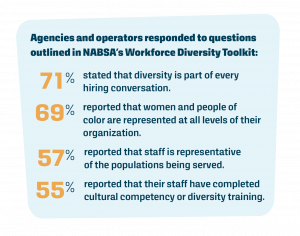Director’s on Diversity – Sam Herr
This post is part of a joint diversity, equity, and inclusion campaign between the North American Bikeshare & Scootershare Association and the Better Bike Share Partnership.
As I sat down to write about NABSA’s core value of Diversity & Equity, I looked back at the very first agenda of the Annual Meeting of members (an event that would later blossom into the NABSA Annual Conference that we know today). In 2014, the event brought together one hundred leaders across the public, private, and nonprofit sectors to discuss what were deemed the most important issues and challenges for the industry at the time. Gathered at the David L. Lawrence Convention Center in Pittsburgh, leaders met in room 304 to discuss how to leverage bikeshare for transportation equity and brainstorm ideas with the newly formed Better Bike Share Partnership (BBSP). From the beginning, NABSA held that equity was a necessary component of building shared micromobility.
NABSA went on to articulate the core value of Diversity & Equity to guide the work of NABSA as well as the industry. Our core value states:
In every area, NABSA promotes an inclusive culture that encourages, supports, and celebrates the diverse voices of its staff, members, and the communities they serve. NABSA expects its members to provide shared micromobility services to riders regardless of race, gender, income, age, or immigration status. Members should make good-faith efforts to engage diverse communities that need low-cost, healthy transportation options, as well as seek to increase the diversity of staff at all levels of their organizations.
To promote and embody this value, NABSA continues to collaborate with BBSP, and has worked with organizations such as the Government Alliance on Race and Equity (GARE), the Biking Public Project, and MUSE Community + Design to create awareness and provide tools for action to NABSA members and shared micromobility stakeholders. We’ve kept diversity, equity, and inclusion at the forefront by featuring keynote speakers such as Keith Benjamin, Jay Pitter, and Stefanie Gidigbi, who have eloquently brought issues of diversity, equity, and inclusion in transportation and shared micromobility to the fore. We established and continue to intentionally cultivate diverse panels and speakers at our Annual Conference. Along with BBSP, we developed a Workforce Diversity Toolkit in 2019 to specifically highlight and respond to the need for more attention and growth in the diversity of the shared micromobility workforce at all levels. The Toolkit also featured some of the good practices being enacted by members as models for others in the industry.
 This year, for the first time, NABSA reported workforce diversity metrics in our 2020 State of the Industry Report released in August. We found that 71% of agencies and operators who responded to the survey stated that diversity is part of every hiring conversation The report also shows that 83% of systems offer discount programs, 74% have alternative payment options, 66% have geographic distribution policies, 56% offer education and outreach programs, and 27% incorporate adaptive vehicles.
This year, for the first time, NABSA reported workforce diversity metrics in our 2020 State of the Industry Report released in August. We found that 71% of agencies and operators who responded to the survey stated that diversity is part of every hiring conversation The report also shows that 83% of systems offer discount programs, 74% have alternative payment options, 66% have geographic distribution policies, 56% offer education and outreach programs, and 27% incorporate adaptive vehicles.
These metrics demonstrate intention and mark progress toward improved equity, diversity, and inclusion in shared micromobility. Yet, we recognize collectively that we are not where we want to be or should be. What is the next step? How can NABSA support the shared micromobility industry in transitioning our awareness into more meaningful action? These are the questions that we’ve been asking ourselves, reflecting on, and thinking deeply about this year at NABSA. Building off of the foundational work that NABSA has done in the past, we are seeking to move into approaches and interventions that are more sustaining through time. We have been collaborating with colleagues at BBSP and New Urban Mobility Alliance (NUMO) to explore this. I’m excited about where this is headed and look forward to engaging NABSA members in this work.
